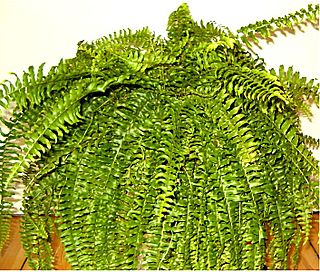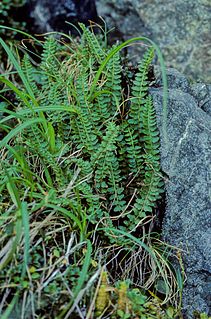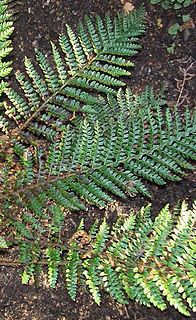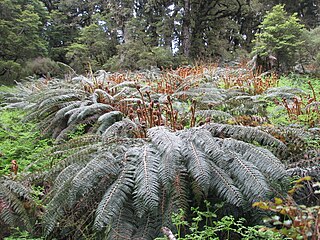Sword fern is a common name for several ferns and may refer to:

A fern is a member of a group of vascular plants that reproduce via spores and have neither seeds nor flowers. They differ from mosses by being vascular, i.e., having specialized tissues that conduct water and nutrients and in having life cycles in which the sporophyte is the dominant phase. Like other vascular plants, ferns have complex leaves called megaphylls, that are more complex than the microphylls of clubmosses. Most ferns are leptosporangiate ferns, sometimes referred to as true ferns. They produce coiled fiddleheads that uncoil and expand into fronds. The group includes about 10,560 known extant species.
- Nephrolepis , a tropical genus of ferns, especially:
- Nephrolepis exaltata , commonly cultivated as a houseplant, including the Boston fern
- Polystichum , a cosmopolitan genus of ferns, especially:
- Polystichum munitum , native to western North America

Polystichum munitum, the western swordfern, is an evergreen fern native to western North America, where it is one of the most abundant ferns. It occurs along the Pacific coast from southeastern Alaska to southern California, and also inland east to southeastern British Columbia, northern Idaho and western Montana, with disjunctive populations in northern British Columbia, Canada; the Black Hills in South Dakota, United States; and Guadalupe Island off of Baja California, Mexico. Western swordfern is known to have locally naturalized in parts of Great Britain and Ireland.

Nephrolepis is a genus of about 30 species of ferns in the family Nephrolepidaceae.

Nephrolepis exaltata, known as the sword fern or Boston fern, is a species of fern in the family Lomariopsidaceae native to tropical regions throughout the world. An evergreen perennial herbaceous plant, it can reach as high as 40–90 centimetres (16–35 in), and in extreme cases up to 1.5 metres. It is also known as the Boston swordfern, wild Boston fern, Boston Fern, Boston Blue Bell Fern, tuber ladder fern, or fishbone fern.

A houseplant is a plant that is grown indoors in places such as residences and offices. Houseplants are commonly grown for decorative purposes, but studies have also shown them to have positive psychological effects. Houseplants also help with indoor air purification. Some species, and the soil-dwelling microbes associated with them, reduce indoor air pollution by absorbing volatile organic compounds including benzene, formaldehyde, and trichloroethylene. While generally toxic to humans, such pollutants are absorbed by the plant and its soil-dwelling microbes without harm. Common houseplants are usually tropical or semi-tropical epiphytes, succulents or cacti.
| This page is an index of articles on plant species (or higher taxonomic groups) with the same common name (vernacular name). If an internal link led you here, you may wish to edit the linking article so that it links directly to the intended article. |










